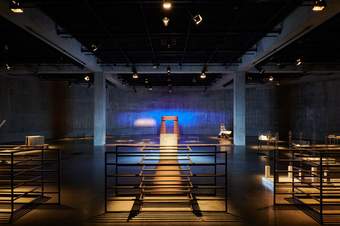Vivan Sundaram’s installation acts as memorial, monument and tomb for an unknown victim
Memorial centres around a photograph of an unidentified man lying dead on the street. Taken by photojournalist Hoshi Jal, the image documents a victim of the 1992–93 Bombay (now Mumbai) riots in India. Sundaram, who lived and worked in Delhi, first encountered the image when it was published in the Times of India.
On 6 December 1992, the Babri Masjid, a sixteenth-century mosque in Ayodhya, was demolished by militant Hindu nationalists. The mosque was built on a contested site, believed to be the birthplace of the Hindu deity Rama. Its demolition incited Hindu-Muslim riots across India, with reverberations in Bangladesh and Pakistan. In Mumbai, rioting in December 1992 and January 1993 resulted in the deaths of an estimated 900 people, the majority of them Muslim.
Sundaram ruminated on the events for six months, with the photograph folded in his wallet. As an artist whose work engages with politics and activism, he felt compelled to respond: ‘I kept thinking, how do I deal with this? I drew on the influence of minimalism that I had grappled with as a student in England, and started thinking of the photograph in spatial terms... The fact that the photograph was a found object, and that I didn’t witness the violence first-hand as my friends in Mumbai did, added another layer: my entry into the tragedy was from a distance.’
In Memorial Sundaram repeats and modifies this image. He pierces and shrouds the photographed figure with nails. He gives the image material form and sculptural presence, creating ‘memorials’ on different scales. The arrangement of these photo-objects invites viewers to walk through the installation at a pace that resembles rituals of mourning. Memorial transforms a single historical moment into a symbolic space. Through the work, Sundaram raises questions about erasure, collective memory, nationalism and citizenship in post-colonial South Asia.

